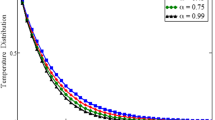Abstract
Turbulent combustion is ubiquitously used in practical combustion devices. However, even chemically non-reacting turbulent flows are complex phenomena, and chemical reactions make the problem even more complicated. Due to the limitation of the computational costs, conventional numerical methods are impractical in carrying out direct 3D numerical simulations at high Reynolds numbers with detailed chemistry. Recently, the lattice Boltzmann method has emerged as an efficient alternative for numerical simulation of complex flows. Compared with conventional methods, the lattice Boltzmann scheme is simple and easy for parallel computing. In this study, we present a lattice Boltzmann model for simulation of combustion, which includes reaction, diffusion, and convection. We assume the chemical reaction does not affect the flow field. Flow, temperature, and concentration fields are decoupled and solved separately. As a preliminary simulation, we study the so-called “counter-flow” laminar flame. The particular flow geometry has two opposed uniform combustible jets which form a stagnation flow. The results are compared with those obtained from solving Navier–Stokes equations.
Similar content being viewed by others
REFERENCES
F. A. Williams, Combustion Theory (Benjamin Cummings, Redwood City, 1985).
N. Peters, Proceeding of the Combustion Institute 21:123–1250 (1986).
S. Chen and G. D. Doolen, Annual Reviews of Fluid Mech. 32–364 (1998).
X. He and G. D. Doolen, Phys. Rev. E 5–1:43–440 (1997).
D. O. Martinez, W. H. Matthaeus, S. Chen, and D. C. Montgomery, Phys. Fluids 6:128–1298 (1994).
S. Chen, D. O. Martinez, and R. Mei, Phys. Fluids 8:252–2536 (1996).
S. Succi, G. Bella, and F. Papetti, J. Sci. Comput. 1–4:39–408 (1997).
K. K. Kuo, Principles of Combustion (John Wiley and Sons, New York, 1954).
O. Filippova and D. Hanel, J. Comput. Phys. 158:13–160 (2000).
H. Tsuji and I. Yamaoka, Proceeding of the Combustion Institute 19:153–1540 (1982).
S. Ishizuka and C. K. Law, Proceeding of the Combustion Institute 19:154–1548 (1982).
M. D. Smooke and V. Giovangigli, Lecture Notes in Physics, Vol. 241 (Springer-Verlag, 1985), pp. –28.
P. A. Libby, N. Peters, and F. A. Williams, Combust. Flame 75:26–280 (1989).
K. Yamamoto, Combust. Flame 118:43–444 (1999).
C. K. Westbrook and F. L. Dryer, Combust. Sci. Technol. 27:3–43 (1981).
D. R. Stull and H. Prophet, JANAF Thermodynamic Tables, NSRDS-NBS 37 (National Bureau of Standards, Washington, D.C., 1971).
J. O. Hirshfelder, C. F. Curtis, and R. B. Bird, Molecular Theory of Gases and Liquids (John Wiley and Sons, New York, 1954).
X. He and Li-Shi Luo, J. Statist. Phys. 88(3/4):92–944 (1997).
R. J. Kee, J. A. Miller, and T. H. Jefferson, Sandia National Laboratories Report, SAND8–8209 (1983).
X. He, S. Chen, and G. Doolen, J. Comput. Phys. 146:28–300 (1998).
I. Yamaoka and H. Tsuji, Proceeding of the Combustion Institute 20:188–1892 (1984).
Author information
Authors and Affiliations
Rights and permissions
About this article
Cite this article
Yamamoto, K., He, X. & Doolen, G.D. Simulation of Combustion Field with Lattice Boltzmann Method. Journal of Statistical Physics 107, 367–383 (2002). https://doi.org/10.1023/A:1014583226083
Issue Date:
DOI: https://doi.org/10.1023/A:1014583226083




